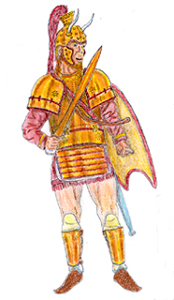 |
The Greek Age of Bronze
Iliad Armour |
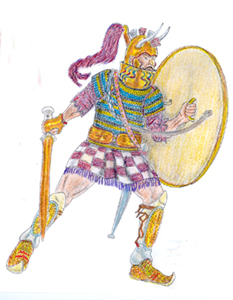 |
In the Iliad the Achaeans are described as wearing bronze(*1). Even if their armour is generically indicated as "Thorek" (*2) in some cases further details are given. Based on these elements an hypothetical recontruction of some of the defence described in the Iliad can be made.
The Iliad's hexameter analysis, and some elements and places described in it, have demonstrated how the poem had its origins in the Mycenaean time (*3) (see also the page dedicated to the Trojan war) thus for all the reconstructions on this page, archaeological elements coming from the Late Helladic period have been reasonably used. |
The first element that we have to consider about Agamemnon's armour is that it comes from Cyprus as a gift from Kinyras.
(Il. XI, 20-21) |
| The armour had ten strips (*4) of black enamel as well as twelve strips made of gold and 20 made of tin (Il. XI, 24-25) |
| Enamel snakes lay toward the neck, three on each side, similar to the rainbows that the son of Kronos places in the clouds as a signal for men. (Il. XI, 26-28) |
| The armour ended at waist level and was equipped with a protection belt because when Agamemnon was hit by Iphidamantes' spear, it is said that the stub hit the belt in the lower part of the armour, but it didn't pass through the decorated belt because the spear's point was bent by hitting the silver part. (Il. XI, 234-237) |
| Agamemnon wears beautiful greaves reinforced with silver ankle protections. (Il. XI, 17-18) |
| Agamemnon puts the sword, shining with golden nails, around the shoulders. The sword's silver scabbard was attached with silver suspensions. (Il. XI, 29-31) |
| The Agamemnon's dagger was hanging near the sword's long scabbard. (Il. III, 271-272 and Il. XIX, 252-253) |
| The shield and the helmet of Agamemnon which are described the Iliad are reconstructed in the pages dedicated to the Iliad shields and Iliad helmets. |
| Based on the above mentioned descriptions two reasonably hypothesis can be made about Agamemnon's armour: a)The armour was a typical Achaean panoply composed of two plates with shoulder guards and (as mentioned in the Iliad) a war belt. The armour can thus be based on the specimens found in Thebes or even on the one from Dendra in this case only equipped with a frontal and back waist plates (see page dedicated to the armour). The armour of course was fully decorated with black, gold and tin stripes as mentioned in the Iliad. The presence of snakes " laying toward the neck" is a possible indication of a neck guard decorated with colourful snakes. We know from archaeological evidences that the neck protections were used in all the Late Helladic periods (see the page dedicated to the armour) so its use in Agamemnon's panoply is fully reasonable. |
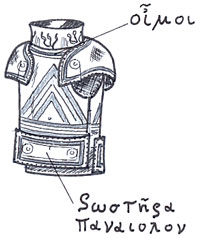 |
An interesting representation of an Achaean style Agamemnon's panoply has been made by Eric Shanower on his awesome mithologically and archaeologically based comic serie AGE OF BRONZE THE STORY OF THE TROJAN WAR. This archaeologically reasonable late Achaean armour shows all of the features of the Agamemnon's armour as described in the Iliad:
decorated with gold, black and tin stripes, snakes similar to the rainbow, and war belts. |
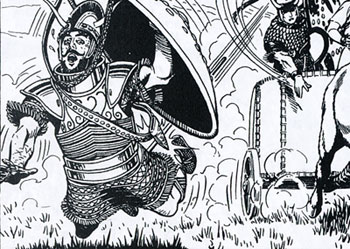 |
A very beautiful bronze hypothetical reconstruction of an Achaean style Agamemnon's panoply has been made by Royal Oak Armoury.
This archaeologically reasonable late Achaean armour shows all of the features of the Agamemnon's armour as described in the Iliad:
decorated with gold, black and tin stripes, snakes similar to the rainbow. (RoyalOakArmoury.com) |
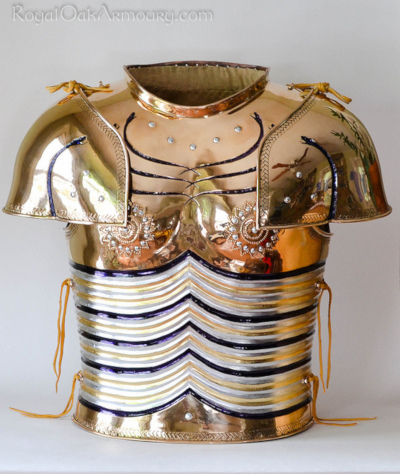 |
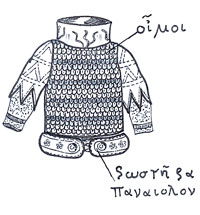 |
b)The second hypothesis is based on the fact that the armour worn by Agamemnon is from Cyprus so more likely it could have been the typical Near Eastern defence made of small overlapped scales which was also used by the Achaeans as attested in some archaeological sources (see the page dedicated to the scale armour) and especially well attested in Cyprus both as scales specimens and art representation. In this case the black, gold and tin stripes have to be intended as the scale's rows painted or made of different materials. The cuirass ended at waist level where a belt was placed. The belt can be reconstructed as the one shows in the pottery fragment from Tiryns (see the page dedicated to the scale armour). Also in this case the presence of a neck guard with this scale armour is fully attested in archaeological sources so it can be reasonably used in the reconstruction as well.
Of course being the total number of rows 44 (10 of gold, 12 black and 20 of tin) and ending the cuirass at the waist of the warrior, the rows have not to be intended all in sequence order one over each other because a scale cuirass made of 44 rows of scales would have been too long. The different rows in gold, black and tin are thus to be considered in all the part of the cuirass like for instance 15 rows in the frontal part, 15 rows in the rear part, and the other 14 rows divided on the shoulder protections. |
A full color image of Agamemnon equipped with a Cypriote cuirass made of overlapped scales on which, divided in the different zones of the armour, there are ten rows of black enameled, twelve of gold and 20 of tin; furthermore a bronze belt decorated with silver motif; neck guard with snakes in "rainbow" color; beautiful greaves reinforced with silver ankle protections, sword with gold nails and silver scabbard, can also be assumed.
The large shield and the elaborated helmets with crests, tubes, and horse plume are fully described in the pages dedicated to the Iliad shields and the Iliad helmets.
The hand protection is not described by Homer but because one specimen was found in Mycenae (see the page dedicated to the greaves and arm-guards ) its use by Agamemnon is reasonable. |
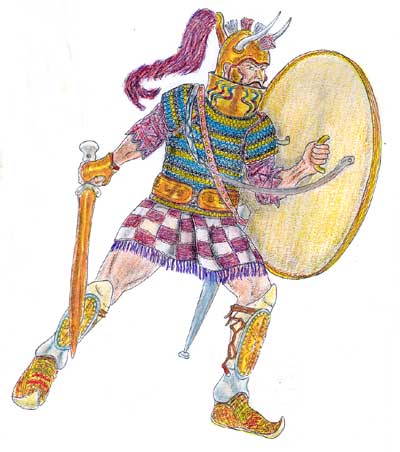 |
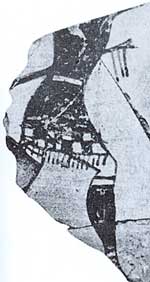 |
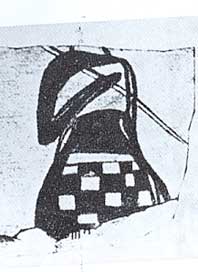 |
The fringed "Kiton" decorated with a checker pattern is represented in a couple of pottery fragments dated LH IIIC respectively from Lefkandi and Mycenae |
| Some elements of the Menelaus' armour are described when he was hit by an arrow thrown by Pandarus. The arrow hit Menelaus's armour where the gold suspensions of the belt were fastened and the armour's plate was double. The arrow went throw the belts, the decorated armour and the protection band " mitra"(*5) worn by the hero for protection (Il. IV, 132-137) |
| Similar indications are given when Macaones opened Menelaus's armour to check the wound. He opened the decorated war belt, underneath the waist and protection band " mitra" that bronze/copper smiths made (Il. IV, 215-216) |
| There are no other indications about Menelaus' armour. Furthermore it is said that his shield was round (Il. III, 347), his sword had silver nails (Il. III, 361) and that he wore a bronze helmet (Il. X, 30-31) |
| Based on the above mentioned few elements Menelaus' panoply could be interpreted as a typical Achaeans armour equipped with belts similar to the ones found in Thebes (in this case decorated) and underneath a lower abdomen protection " mitra" probably attached to a waist belt as shown in the "warrior vase" from Mycenae (see the page dedicated to the corselets) . |
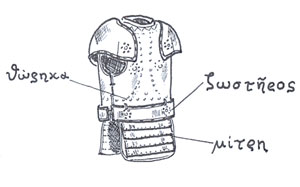 |
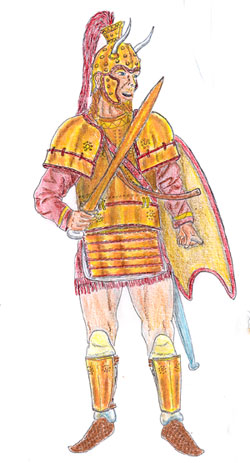 |
A full color reconstruction of Menelaus wearing a typical Achaean bronze armour composed of a cuirass, shoulder protections, belts (in this case attached to the lower edge of the cuirass with golden hooks) and a lower abdomen protection "mitra". These elements are mainly based on the findings from Thebes and Mycenae, as well as Late Helladic pottery representations and Linear B descriptions (see pages dedicated to the armour and the corselets). In this reconstruction Menelaus is also equipped with bronze greaves which are based on the specimen from Enkomi. These are reinforced with silver ankle protections which are based on the questionable elements found in Mycenae (see the page dedicated to the greaves). His helmet has been reconstructed taking into acount a hypothetical bronze interpretation of the helmets depicted in the "warrior vase" from Mycenae as well as his round shield. |
| In the Iliad very few elements are described about the two panoplies of Achilles. The first panoply was given to Patroclus and after his death it was used by Hector. The second armour worn by Achilles in the duel against Hector was forged by Hephaestus to replace the first one which was stolen. Because of the very few described elements related to these panoplies, the reconstructions are based on the hypothesis made by Peter Connolly (*6) and described by Dr. Raffaele D'Amato in his booklet includes in the metal figurines kit (*7). |
| The first Achilles panoply is described as dazzling bronze colored and speckled with stars. Greaves reinforced with silver ankle protection are also indicated (Il. XVI, 130-134) |
| When Hector takes the armour from the dead Patroclus. It is also said that the cuirass comes unlaced (Il. XVI, 804) |
 |
A very beautiful representation of Achilles' first panoply has been drawn by Giorgio Albertini. In this painting the armour is shown worn by Hector during his final duel against Achilles. Based of the few above mentioned indications the armour has been assumed as a typical Achaeans panoply composed of a cuirass, shoulder guards and belts. Based on the specimens found in Dendra and Thebes the various elements were attached to each other by means of thongs thus in accordance with the Iliad statement that the armour "comes unlaced".
The panoply has been represented in shining bronze speckled with stars. The stars have been reproduced on the basis of armour fragments found in Slovakia (see the page dedicated to the armour). But the Iliad described its vivid colours: so it is likely to imagine the stars first embossed on the cuirass surface and then painted with minium red, the war color preferred by the Achaeans. The Central Europe helmet and the full-body shield represented in the painting are fully described in the pages dedicated to the Iliad helmets and the Iliad shields. |
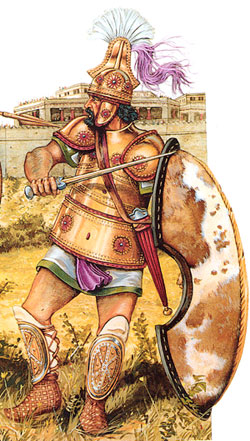 |
| The new splendid weaponry of Achilles were forged by Hephaestus, God of craftsmen, through the intercession of the Achilles' mother Thetis. He used copper, tin (the basic elements of bronze) silver and gold (Il. XVIII, 474-475) |
| Even less elements are given about Achilles' second panoply. Indeed it is said that the armour was shining more than a fire's blaze (Il. XVIII, 610) |
| An interesting detail about this panoply is when Achilles put on his sacred armour, in fact he tested it to see if it allowed his limbs free movement. This would be essential for anyone wearing a typical Achaean armour with large shoulder guards and girdle plates. Of course this would not be necessary if he were wearing a much simpler cuirass or corselet. (Il. XIX, 384-386) |
| Achilles is described wearing beautiful greaves reinfoirced with silver ankle protectons and a bronze sword with silver nails. (Il. XIX, 369-372) |
 |
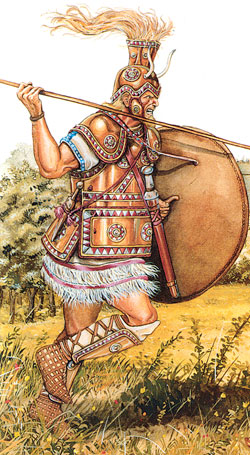 |
Also in this case a beautiful representation of this panoply has been drawn by Giorgio Albertini. In this painting the armour is shown worn by Achilles during his duel against Hector. Based of the few above mentioned indications the armour has been logically assumed as a typical Achaeans defence composed of a cuirass, shoulder guards and belts reasonably based on the specimens found in Dendra and Thebes.
According to the Iliad's description, the panoply is represented in a shining bronze. Also in this case the panoply has been assumed as decorated with embossed stars (which seems to be an haraldic emblem of Achilles), mentioned by Homer about the first panoply. This second armour has been decorated in red color plus some of the metals used by Hephaestus, like gold and silver. The crested helmet and the fully decorated shield are described in the pages dedicated to the Iliad helmets and the Iliad shields. |
A very beautiful bronze hypothetical reconstruction of an Achaean style Achilles' panoply has been made by Royal Oak Armoury.
This archaeologically reasonable late Achaean armour shows all of the features of the Achilles' armour as described in the Iliad:
dazzling bronze colored and speckled with stars. (RoyalOakArmoury.com) |
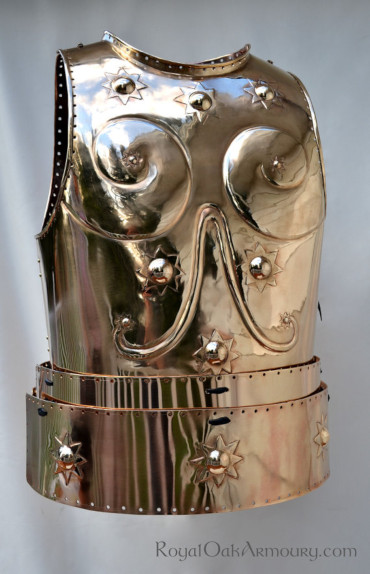 |
| DIOMEDES: He worn a bronze armour with a possible indication of shoulder guards because Pandaros wounds Diomedes in the right shoulder between the cuirass concavity (Iliad V, 98-99) and (Iliad V, 188-189) |
| The words Thorax gualon is also used by Homer five times to indicate the concave part of the armour thus not necessarily for the shoulder guard. However considering that in the above mentioned description Homer specify that the cuirass concavity is related to the shoulder we can't exclude that the words Thorax gualon could indicate in these cases the concavity plate of the cuirass' shoulder guard, also condidering that in the shoulder area a simple cuirass does not have any particular concavity. |
| IDOMENEUS: He was also wearing a bronze armour because the bronze is shining on his chest (Iliad XIII, 245). |
| AJAX OILEUS: He is described with a linen cuirass. (Iliad. II, 259) |
| ODYSSEUS: He was wearing a decorated cuirass. (Iliad. XI, 436) |
| HECTOR: His whole body was cased in the tremendous bronze. (Iliad. XIII, 192) |
| MEGETES: His armour is described massive with well connected plates. This armour could also been intended as a segmental armour reinforced made of several plates (see the page deicated to the armour). (Iliad. XV, 229-230) |
| ASTEROPAEUS: His armour taken by Achilles is described in solid bronze with a glittering overlay of tin. (Iliad. XXIII, 560-562) |
| AJAX TELAMONIUS: He is described as wearing the bronze, so more likely he was also equiped with a bronze armour, at least during his duel against Hector. (Iliad. VII, 206) |
| POLYDORUS: His armour is described similar to the one of Menelaus with belt fastened by gold suspension where the armour's plate was double. (Iliad. XX, 415) |
| MENESTHIUS: He is one of the Myrmidon field commanders described with a shining armour. (Iliad. XVI, 173) |
| (*3) JOACHIM LATACZ, Troy and Homer, Towards a solution of an old mystery OXFORD UNIVERSITY PRESS (2004). |
(*6)PETER CONNOLLY The leggend of Odysseus OXFORD UNIVERSITY PRESS 1986.
|
(*7)Metal figurine from SOLDIER Hector and Achilles Archaeological Research by RAFFAELE D'AMATO sculpture by ADRIANO LARUCCIA
|
|